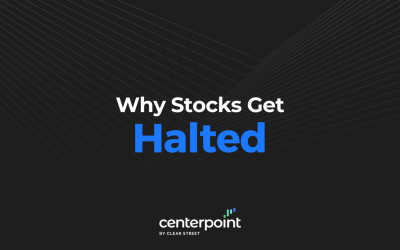In these volatile markets, it’s prudent for traders to have the capacity to play both directions of a stock’s price move – up and down. This means being able to trade stocks long and short.
Long trades involve buying a stock to sell at a higher price for a profit. Short trades involve selling a stock you don’t own with the intention to buy back at a lower price.
In order to short sell a stock, you need to be able to borrow shares to sell. Generally, this process happens behind the scenes and the process is facilitated by your broker. Your broker borrows shares of a stock and lends them to you so you can place a short trade. These borrowed shares will be returned at a later point when the short position is closed (known as “covering”).
Since you are technically borrowing shares, you will need to have a margin trading account.
The idea of selling shares you don’t own can be a tough concept to grasp for new traders, so let’s review the process.
How Short Selling Works
Most traders and investors become immediately oriented to the concept of a long position – profiting from rising prices. The adage, “buy low, sell high” applies. This describes the objective of any long trade or investment, which is to buy a position at a lower price and try to make a profit by selling the position at a higher price. Short selling applies the same concept in reverse.
The objective of short selling is to profit from falling prices. The adage in this case would be to, “sell high, buy back lower”. In order to sell shares of stock that you don’t own, you would have to borrow shares from someone who does.

What is a “Short Locate”?
Every morning custodial brokers assess the inventory of stocks with shares available for borrow. The most widely traded stocks in the S&P 500 usually have shorts available to borrow and are placed on an internal “Easy to Borrow” list. Short selling any of these stocks is fluid and frictionless for the end user.
Moving down the tiers of liquidity, the availability of short shares may become smaller both in terms of short-ability and number of shares available for borrow. If you encounter a stock that shows no availability of short shares, then you could request a “Short Locate” with your broker.
Some brokers will provide an updated list or affix a notification on stocks that are “Hard to Borrow” (HTB) to let traders know ahead of time the unavailability of short shares. Stocks found on the HTB list will either be unavailable to borrow or require fees to attain shares.

Why Do You Need Locates?
If you are a short seller, your entire trading strategy relies on your ability to borrow shares.
Imagine identifying the perfect short setup only to find out you can’t actually trade it. While this is hardly an issue for long-biased traders, it’s a common phenomenon for short sellers (especially those who utilize niche strategies like small-cap short selling).
Simply put, having access to short locates allows you to actually execute your trading plan.
How Does the “Locate” Process Work?
Depending on your brokerage trading platform, you may be able to request a Short Locate directly through the platform. Direct access trading platforms tend to have embedded Short Locate capabilities for this process. Otherwise, you may need to contact a trading specialist through customer service and request the stock and shares over the phone or through a messenger or chat support, if available.
Once you request the stock and the maximum number of shares you wish to borrow, the broker will search on their end for the availability and quantity of borrowable shares through a network of sources.

Locate Fees
If your broker is successful in locating borrowable shares, they will notify you of the available shares and the associated locate fee, which can vary based on supply and demand. You will be given the option to accept or cancel.
If you accept the shares, then the locate fee gets applied to your account making the short shares available for the day. Keep in mind, the locate fees apply whether you end up using the located shares (i.e. short selling) or not. Accepting the shares doesn’t equate to shorting the shares.

Not All Locate Services Are Created Equal
We mentioned earlier that stock locate services are provided by your broker. It should be noted that not all locate services are equal. Brokers don’t simply tap into a shared inventory of stocks to borrow. Borrowable shares can be located from a variety of sources and different brokers have access to different pools of inventory.
If you utilize a niche short-selling strategy, you will need a broker that has the best opportunity to access the locates you require.
How to Find Better Locates
First things first, you need to have an account with a broker that specializes in short inventory and locate services.
Different brokers will have varying levels of short inventory on hand or have the ability to locate HTB shares. Keep in mind not all brokers provide short locates nor do the most popular online brokers provide better locates. For these reasons, it’s important to choose a direct market access broker who specializes in short locates.
Here are some things you want to look for:
- Hard-to-borrow (HTB) short locate services (and third-party services)
- Short locate tools embedded in trading platforms
- Short locate hours of availability
- Short locate fees for HTB stocks
- Margin rates for HTB shorts
Once you find an adequate broker, you should make a habit of securing the shares you need as early as possible. It’s better to have the shares and not need them then need them and not have them.
Is Short Selling for Everybody?
No, short selling is not for everybody. You should have a high-risk tolerance if you plan on implementing short selling strategies. Short selling comes with additional risks generally not associated with buying long. For starters, when you buy a stock, the maximum amount you can lose on the trade is limited to the total cost of the purchase. When you sell a stock short, the maximum loss is unlimited. On the long side, the stock’s price cannot go below zero. On the short side there is no limit on how high the price can go. There are also fees that can be much higher on the short side than the long, such as short interest charges and locate fees. Be sure to talk to your broker if you do not have a thorough understanding of the fees associated with selling short







